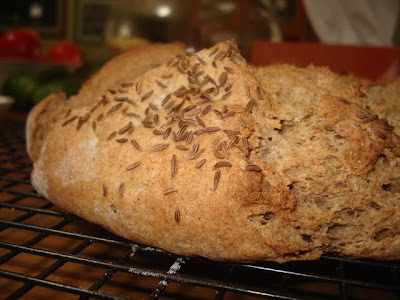I think one of the most important, and certainly one of my most frequently used home skills, is bread making. It is important in that it allows us to have a good wholesome lunch most days that, with the addition of our backyard salads, or some local cheese or even a scrape of Vegemite, is food fit for the most queenly of queens. I have had the Artisan Bread in Five Minutes book for a few months now but I've been under-whelmed by it. It gives what look to be good recipes but it doesn't inspire me to rush out and make them. I will get back to sour doughs soon, I do believe they have an important place in my kitchen, but until this batch of yeast runs out and I perfect a good starter, I'm sticking to my yeasted recipe.
This recipe is really just an adjustment of my white bread one - it's four cups of flour, bubbling yeast, warm water, sugar and salt. You could even leave out the sugar and salt if you wished, but they do add flavour. Rye flour contains a small amount of gluten, therefore the bread doesn't rise as much as a white loaf does. To help with the rising, I add half a cup of unbleached white baker's flour. It gives the loaf a bit of a spring.
RECIPE
- 2 teaspoons yeast - dissolve in a cup of warm water to which the brown sugar is added. Let it froth up.
- 1 tablespoon brown sugar.
- about 2 cups of warm water. This amount is approximate. The amount of water to flour will change according to the humidity in the aim and the flour you use. Add 1¾ cups first, mix, then add the last ¼ slowly. You may even need more than this amount. Just add it slowly. When rye dough is too wet it becomes very sticky.
- 3½ cups rye flour and ½ cup unbleached white baker's flour (strong flour)
- 1 teaspoon salt. Don't add the salt to the yeast water because the salt could kill the yeast. Add it in with the flour.
Into your breadmaker, place 3½ cups rye flour, ½ cup unbleached white baker's flour and the salt. When the yeast cup is frothy, add that and the rest of the water, slowly. Turn on the machine and let it mix. Feel the dough. You always have to do this and you should learn what a good dough feels like. If the dough feels too dry, or if there is still some dry flour in the bucket that hasn't mixed in, add a very small amount of water to help it mix in. If the dough is too sticky you may need a small amount of additional flour. Feel it again and watch it mix. The flour and water should come together well and not be sticking to the sides of the bucket. You will notice as it kneads, the smoother the dough becomes. What you want at the end is a smooth and elastic dough that springs back when you poke your finger in it. BTW, this recipe is fine when made by hand as well.
When the timer tells you the dough cycle is finished, take the dough out and put it on a lightly floured clean bench. Knead it for a minute to put yourself into it and form it into the shape you like. Rye dough is very easy to shape and it should hold itself free-form, so you don't have to use a bread tin, but you can if you want to.
For every grain there is a seed that complements and enhances its flavour. For rye, that seed is the caraway. If you intend making rye bread, do yourself a favour and find some caraway seeds. Brush the top of the dough with water and sprinkle on your seeds. Place in a warm position to rise. When the dough is the size you want, place it into your preheated very hot oven (as hot as your oven will go), then turn it down to about 190 - 200C / 375 - 390F. Bake for about 20 minutes or until you smell the bread and it looks cooked.
I experimented with this flour for a week or so, starting of with half white and half rye. The recipe above is the one we thought was the best. However, like every recipe, I hope you experiment with it and suit it exactly to your taste. I think recipes are just a starting point, they're there to show you how, and if you know what to look for, particularly when you're making bread, it should be quite easy for you to adjust the recipe to suit yourself.
Happy baking everyone.






